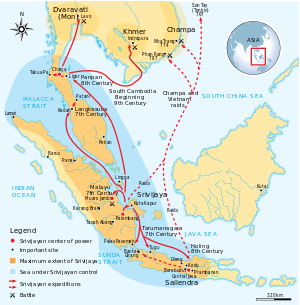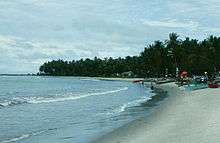Barus
Barus is a town and kecamatan (district) in Central Tapanuli Regency, North Sumatra Province, Sumatra, Indonesia. Historically, Barus was well known as a port town on the western coast of Sumatra where it was a regional trade center from around the 7th or earlier until the 17th century. It was also known by other names, namely Fansur and possibly Barusai.[1] The name Fansur or Pansur means "spring of water" in the local Batak language.[2] Barus was well known for its produce camphor. In the 16th century, Barus came under attack from the rising power of Aceh, and became absorbed into the Aceh Sultanate. The earliest known Malay poet Hamzah Fansuri may be from Barus as indicated by his name.

Historical records

Barus was a significant settlement on the west coast of Sumatra widely recorded in many historical documents. Other related sites in Sumatra includes Lamuri in Aceh and Pannai in North Sumatra.[3] The second century Greek geographer Claudius Ptolemy in his work Geography recorded the name Barusai (or Baroussai) as a group of five islands, which some scholars believe to refer to islands facing the Western Sumatran coast at Barus.[4][5] The Indian text Mañjuśrī-mūla-kalpa makes a reference to a Warusaka that may be Barus.[6] In 4th Chinese records, the name "Po-lu" is found, suggested to mean Barus or the northern part of Sumatra. During the Tang dynasty, the Chinese traveller Yijing mentioned the island of Polushi (婆魯師洲) to the west of Palembang where Mulasarvastivada Buddhism was practiced.[4] Arab sources use the name Fansur or Pansur, the 9th century Arab geographer Ibn Khurdadhbih also used the term the "island of Bālūs", although the Arabs appeared to consider Bālūs different from Fansur.[7] Around 900 Ahmad ibn Rustah called Fansur "a well known country in the Indies" and wrote about its jurisdiction.[6]
The best-known commodity produced and traded in Barus was camphor, locally known as kapur barus (lit. "Barus' chalk"). One of the earliest mentions of Barus in Muslim sources may be by Sulaiman who wrote in 851 of gold mines and "plantations called Fansur, where one obtains a superior quality of camphor".[6] In the 10th century Al-Masudi wrote that "... the land of Fansur, whence is derived the fansuri camphor, which is only found there in large quantities in the years that have many storms and earthquakes".[8] In the 13th century, the Chinese writer Zhao Rugua wrote in Zhu Fan Zhi that Binsu (賓窣, Pansur) was one of the countries producing camphor.[9] According to the Venetian traveller Marco Polo, the camphor from Fansur was the best in the world, its quality "so fine that it sells for its weight in fine gold".[10]
Barus may have been an important site during the Srivijaya period; Xin Tangshu says that "Srivijaya is a double kingdom and the two parts have separate administration", and that its western kingdom was Barus.[11] There may have been Tamil presence in the 11th century; four inscribed stones have been found in Barus, one in Tamil known as the Lobu Tua Inscription has been dated to 1088. It named the local inhabitants as Zabedj, a name also found in Arabic sources as Zabag or Zabaj and may refer here to the Batak people. A 13th century source mentions that there were once Christians there, although no trace of these early Christians remains.[2] In Indonesian sources, Barus is mentioned in Carita Parahyangan as one of the conquests of King Sanjaya. It is also named in the 1365 Old Javanese epic poem Nagarakretagama as one of the vassal states of the Majapahit that formed part of 'tanah ri Malayu'.[6]
Barus has not been located in the same place all through its history; a Batak chronicle mentions that Barus had moved three times.[2] Older sites may decline and become abandoned. In the 16th century, Barus was a prosperous port; the Portuguese writer Tomé Pires mentioned in Suma Oriental the "very rich kingdom of Baros" that was also known to people from many nations as "Panchur" or "Pansur". The first known Malay poet Hamzah Fansuri may have been either born or raised in Barus in this period. Barus was then dominated by the Aceh Sultanate around the middle of the 16th century and an Acehnese Panglima or governor was stationed there. Later it came under the influence of the Dutch East India Company in 1668 after they ousted the Acehnese Panglima. The area also came under the influence of the Minangkabaus and became part of the Malay cultural sphere.[12]
Archaeology
Archaeological excavations at several sites around Barus have uncovered significant evidence of human settlement and trading activity. These settlements were inhabited at different times. A site a few miles to the north of modern Barus at Lubok Tua (or Lobu Tua) produced artifacts of Chinese, Arab, Egyptian, Persian, and Indian origin.[2][13] Lubok Tua however was abandoned around the turn of the 12th century. A site at Bukit Hasang was settled from the mid-12th century and abandoned in the 15th, but resettled again in late 15th to mid-16th century. Tombstone found in the area, of which one of the earliest may be dated to 1370, indicate Arabic, Persian and possibly Chinese influences or presence.[14][15] The site at Kedai Gadang was occupied from the 13th to the 19th century.[16]
Gold and silver coins found in Barus indicate it may have produced a currency as early as the 10th century, which may be the earliest found in Sumatra.[14]
Present-day Barus
_Kecamatan_Barus%2C_Tapanuli_Tengah.svg.png)
Barus at present is a small town and a district in the Central Tapanuli Regency in North Sumatra. It is located to the northwest of Sibolga along the Sumatran coast. There are two main kampungs in the town. Both are located along the Batu Gerigis river, one upstream (Mudik) and one downstream (Hilir), with the one downstream on the river mouth now the center, although in the past the one upstream was more important.[17] Most of the population are Batak.
Located near the town of Barus and in Northern Barus are the Islamic tombs of Mahligai and Papan Tinggi which have been developed as tourist attractions.[18]
See also
References
- Drakard, Jane (1989). "An Indian Ocean Port: Sources for the Earlier History of Barus". Archipel. 37: 53–82. Retrieved 9 October 2015.
- John N. Miksic (15 November 2013). Singapore and the Silk Road of the Sea, 1300–1800. NUS Press. pp. 79–84. ISBN 978-9971695743.
- O. W. Wolters, Early Indonesian Commerce, A Study of the Origins of Srivijaya. Ithaca, Cornell University Press, 1967, pp. 181-96
- G. E. Gerini. "Researches on Ptolemy's geography of Eastern Asia (further India and Indo-Malay archipelago)". Asiatic Society Monographs. Royal Asiatic Society. 1909: 428–430.
- Dominik Bonatz; John Miksic; J. David Neidel (eds.). From Distant Tales: Archaeology and Ethnohistory in the Highlands of Sumatra. p. 171. ISBN 9781443807845.
- L.F. Brakel (1979). "HAMZA PANSURI: Notes on: Yoga Practies, Lahir dan Zahir, the 'Taxallos', Punning, a Difficult Passage in the Kitāb al-Muntahī, Hamza's likely Place of Birth, and Hamza's Imagery". Journal of the Malaysian Branch of the Royal Asiatic Society. 52 (1:235): 73–98. JSTOR 41492842.
- R. A. Donkin (18 December 1998). Dragon's Brain Perfume: An Historical Geography of Camphor. Brill. p. 130. ISBN 978-9004109834.
- E. Edwards McKinnon (October 1988). "Beyond Serandib: A Note on Lambri at the Northern Tip of Aceh". Indonesia. 46: 102–121.
- Chau Ju-kua: His Work On The Chinese And Arab Trade In The Twelfth And Thirteenth Centuries, Entitled Chu-fan-chï. Translated by Friedrich Hirth; William Woodville Rockhill.
- Marco Polo; Sir Henry Yule; Henri Cordier. The Travels of Marco Polo: The Complete Yule-Cordier Edition (New ed of 1903 ed.). Dover Publications Inc. pp. 299–300. ISBN 978-0486275871.
- John Norman Miksic; Goh Geok Yian. Ancient Southeast Asia. p. 288. ISBN 9781317279044.
- Drakard, Jane (1990). A Malay Frontier: Unity and Duality in a Sumatran Kingdom. Southeast Asia Program Publications. pp. 3–10. ISBN 9781501719080.
- John Norman Miksic; Goh Geok Yian (31 October 2016). Ancient Southeast Asia. Routledge. ISBN 9780415735544.
- R Michael Feener; Patrick Daly; Anthony Reed, eds. (January 1, 2011). Mapping the Acehnese Past. Brill. pp. 31–33. ISBN 978-9067183659.
- Bastian Zulyeno, Ghilman Assilmi (July 2018). "Representation and Identity of Persian Islamic Culture in Ancient Graves of Barus, North Sumatra". International Review of Humanities Studies. 3 (2). doi:10.7454/irhs.v3i2.65.CS1 maint: uses authors parameter (link)
- John Norman Miksic; Goh Geok Yian (31 October 2016). Ancient Southeast Asia. Routledge. ISBN 9780415735544.
- Drakard, Jane (1990). A Malay Frontier: Unity and Duality in a Sumatran Kingdom. Southeast Asia Program Publications. pp. 1–2. ISBN 9781501719080.
- Irwan Syari Tanjung, Suwardi Lubis, Moh. Hatta (February 2019). "Developing Tomb-Based Religious Tourism: Creating Inter-Cultural Communication Competence in Central Tapanuli Regency" (PDF). International Journal of Research & Review. 6 (2).CS1 maint: uses authors parameter (link)
| Wikimedia Commons has media related to Barus. |